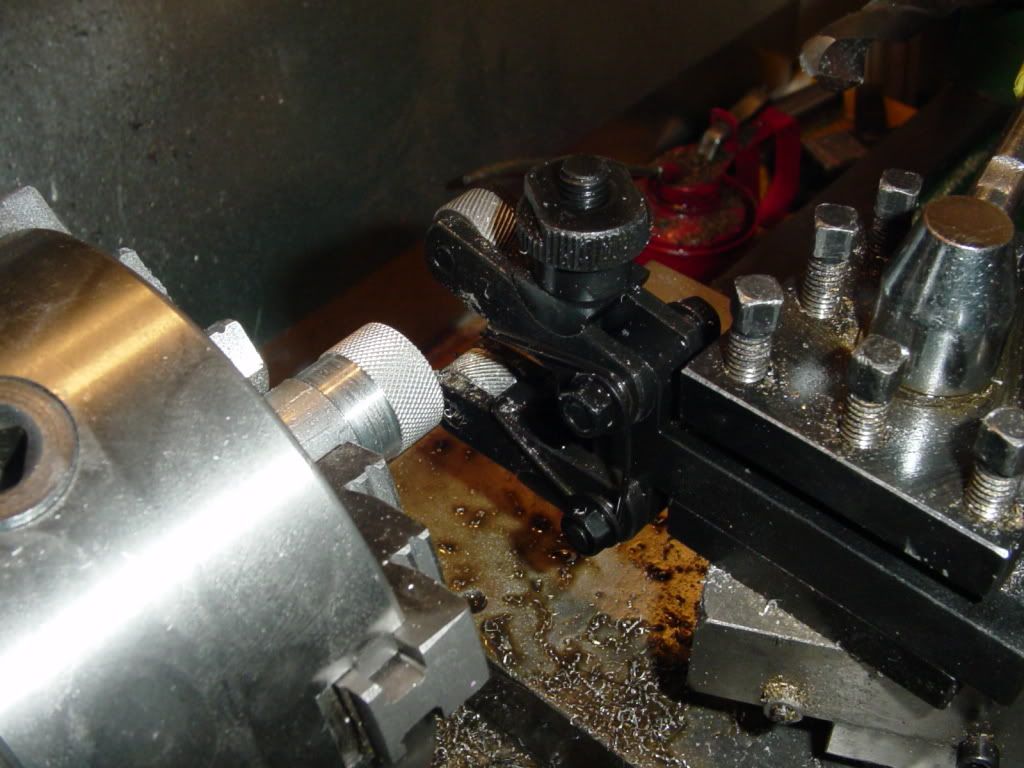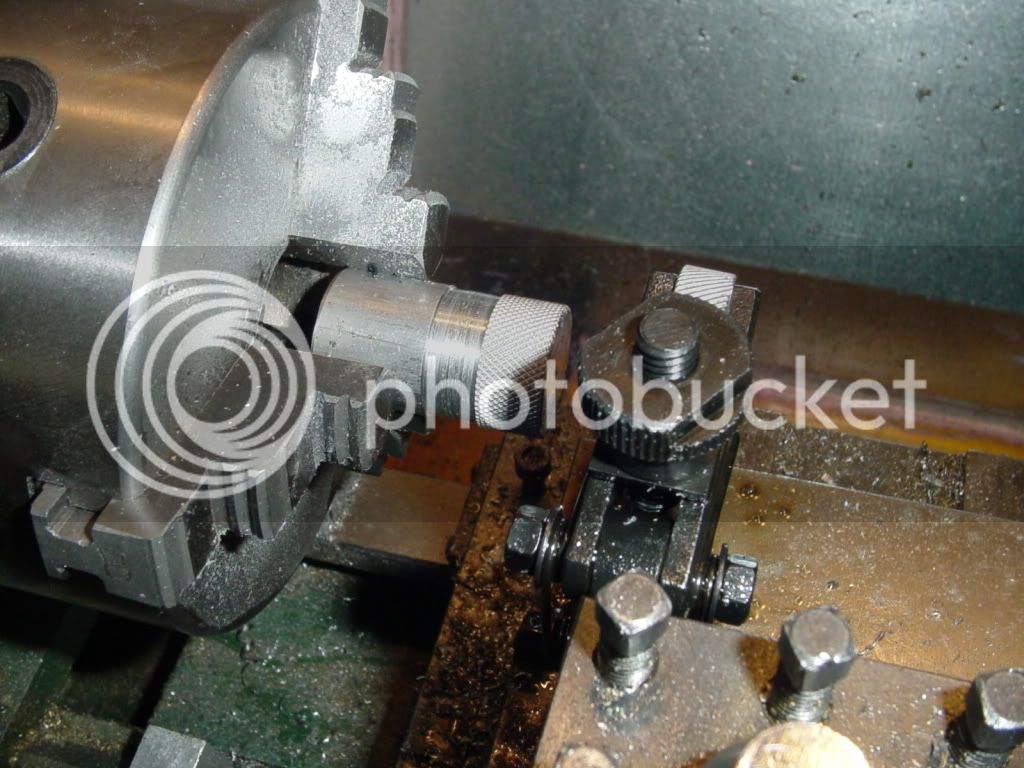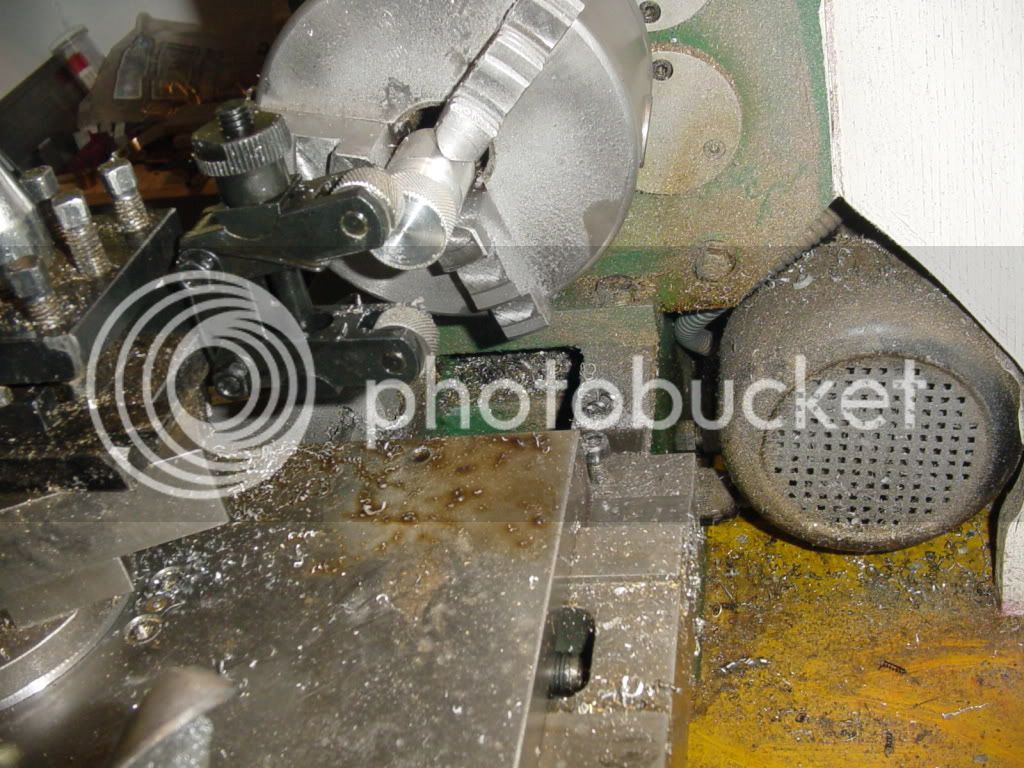I want to knurl something on my Craftex lathe. I have been doing a little research, and it seems that the best type of knurling tool is a "pinch" type knurler. The power feed screw on my lathe doesn't work. (Thats a whole other story). Do knurlers self feed or do they require a power feed screw? Any help would be appreciated. I don't want to build a knurling tool, I just want to know enough about them to buy the right thing.---Brian
You are using an out of date browser. It may not display this or other websites correctly.
You should upgrade or use an alternative browser.
You should upgrade or use an alternative browser.
Need insight into knurling on a lathe
- Thread starter Brian Rupnow
- Start date

Help Support Home Model Engine Machinist Forum:
This site may earn a commission from merchant affiliate
links, including eBay, Amazon, and others.
hey brian im fairly new to machining world but i made my own knurling tool and i just used the hand wheel for mine and it came out pretty good for me. ive been finding out that a little lube really helps a lot for cleaning out the grooves.
hope this is of some help.
hope this is of some help.
Good day Brian,
I have the same lathe. I also have an AXA clone QCTP (Phase II). Some years ago I bought an inexpensive "pinch" knurling tool which I used on my small Taig lathe. It worked OK put it got to the point that I was spending more time tweaking and rebuilding the thing than I was knurling with it. The basic design was ok just the quality of steel that it was made it prone to excessive wear.
After much fussing, thinking, and research I took the plunge and got a genuine Aloris AXA #19 adjustable knurling tool holder. This is not the same as the simple plunge knurling tool which comes with most AXA QCTP style kits but is a "pinch" type and is very well made and rather large and robust. Expensive yes but you can shop around for better prices and it will last my lifetime and then some. I haven't had any more troubles with knurling since I got it (after a short learning curve of course - new tool and all that).
When knurling you can feed with the carriage wheel or under power. In fact for short (an inch or so) jobs I simple set up and feed by hand. If I had a longer section - say 6 inch's or more I would feed under power.
cheers, Graham in Ottawa Canada
I have the same lathe. I also have an AXA clone QCTP (Phase II). Some years ago I bought an inexpensive "pinch" knurling tool which I used on my small Taig lathe. It worked OK put it got to the point that I was spending more time tweaking and rebuilding the thing than I was knurling with it. The basic design was ok just the quality of steel that it was made it prone to excessive wear.
After much fussing, thinking, and research I took the plunge and got a genuine Aloris AXA #19 adjustable knurling tool holder. This is not the same as the simple plunge knurling tool which comes with most AXA QCTP style kits but is a "pinch" type and is very well made and rather large and robust. Expensive yes but you can shop around for better prices and it will last my lifetime and then some. I haven't had any more troubles with knurling since I got it (after a short learning curve of course - new tool and all that).
When knurling you can feed with the carriage wheel or under power. In fact for short (an inch or so) jobs I simple set up and feed by hand. If I had a longer section - say 6 inch's or more I would feed under power.
cheers, Graham in Ottawa Canada
Brian
Use lots of coolant or oil.You want to keep as much of the swarf as you can away from the knurling wheels so they don't try to embed it back into the piece.
You can use a hand wheel.
Clamp types are the way to go. The bump style are really hard on the head stock from what I have heard.
I made a clamp type fro my 7 x 12 and it did a good job. I have knurled about 4 pieces and all but the last one had real good knurls. Don't know what happened on the last one but it had double knurl pattern.
Hope this helps.
Ron
Hi Brian,
I have used my homemade pinch/ scissor type knurling tool quite a few times, notice I said I have used not I have knurled The difficult part of knurling is getting the correct diameter and that involves math or trial and error. It's a lot easier to knurl AL than steel and has been said use a lot of oil, I usually stop the lathe (without moving the knurler) and clean off the chips with air and a tooth brush turning the chuck by hand. Sometimes I get a good diamond pattern sometimes not. All of my knurling has been for a short length so I just use the hand wheel.
The difficult part of knurling is getting the correct diameter and that involves math or trial and error. It's a lot easier to knurl AL than steel and has been said use a lot of oil, I usually stop the lathe (without moving the knurler) and clean off the chips with air and a tooth brush turning the chuck by hand. Sometimes I get a good diamond pattern sometimes not. All of my knurling has been for a short length so I just use the hand wheel.
I have used my homemade pinch/ scissor type knurling tool quite a few times, notice I said I have used not I have knurled
mklotz
Well-Known Member
The 'correct diameter' controversy is almost as charged as a metric-Imperial discussion.
A (seeming) minority of folks think the diameter is important. Initially I felt that way and wrote a program (KNURL on my page) to calculate the 'correct diameter' (there's a lot of controversy about what constitutes "correct"). I've never had a bad knurl using the program but that may be a fluke.
Most folks (including a large proportion of the oldtimers) advise mashing the knurl into the work until it 'finds' the correct diameter to give a nice knurl. Surprisingly, in my experience, this almost always works as advertised.
Whichever approach you take, use lots and lots of oil - I use sulphurated cutting oil because it's handy. Knurling is a metal displacement process so technically you're not cutting anything. However, you'll soon discover that the pressure deformation of the metal produces flaking (especially so in brass) and, unless these flakes are flushed away with oil, they will bung up the knurl.
Knurling has the potential to be very dangerous. Keep rags away from the tool while it's working. (Actually, you shouldn't ever have rags around the lathe.) An old tooth brush will keep your fingers away from the knurls. The first time the knurling tool 'eats' a tooth brush you'll understand only too well why I warn you about being extra careful.
A (seeming) minority of folks think the diameter is important. Initially I felt that way and wrote a program (KNURL on my page) to calculate the 'correct diameter' (there's a lot of controversy about what constitutes "correct"). I've never had a bad knurl using the program but that may be a fluke.
Most folks (including a large proportion of the oldtimers) advise mashing the knurl into the work until it 'finds' the correct diameter to give a nice knurl. Surprisingly, in my experience, this almost always works as advertised.
Whichever approach you take, use lots and lots of oil - I use sulphurated cutting oil because it's handy. Knurling is a metal displacement process so technically you're not cutting anything. However, you'll soon discover that the pressure deformation of the metal produces flaking (especially so in brass) and, unless these flakes are flushed away with oil, they will bung up the knurl.
Knurling has the potential to be very dangerous. Keep rags away from the tool while it's working. (Actually, you shouldn't ever have rags around the lathe.) An old tooth brush will keep your fingers away from the knurls. The first time the knurling tool 'eats' a tooth brush you'll understand only too well why I warn you about being extra careful.
Well Damn!!! That was almost too easy. I rushed off to BusyBee Tools at noon and paid $25 (on sale) for a scissor type knurler with a 5/8" square shank. I set it up in the toolpost of my lathe, --it appears that the shank of the knurler doesn't really have to be centered horizontally on the chuck centerline, as this type of knurler is somewhat "self centering" due to the pivot points on the upper and lower arms---but it should be "fairly close". I took care to align the upper and lower knurling rolls with the center of the chuck vertically (when viewed from above). I chucked up a length of 1" round aluminum scrap and closed the knurlers via the single adjusting screw untill they just "kissed" the outer diameter of the round aluminum, then backed the compound rest towards the tailstock untill it was just clear of the part I wanted to knurl. I closed the knurl adjusting screw by about half a turn, squirted everything with some used motor oil, set the machine for 115 RPM, said a quick prayer to the machining Gods and turned on the lathe. I advanced the knurling tool slowly towards the workpeice (away from the tailstock) untill I could see both of the knurling wheels begin to rotate from contact with the revolving workpeice, then advanced the feed (away from the tailstock) untill the knurl had completely passed over the area I wanted to knurl. I then backed it off and usd an old paintbrush I have to clean the oil and swarf away. It looked good, but not quite deep enough. I advanced the knurling adjustment screw another 1/4 turn (this seems very sensitive--a little turn makes a big difference in knurl depth). and repeated the process.---and Voila---It worked. I am sure that ther are a thousand things left to learn about this, but for a first time event, I was surpised and pleased at how simple it was.---Brian






tel
Well-Known Member
- Joined
- Feb 8, 2008
- Messages
- 3,293
- Reaction score
- 44
My usual technique differs a bit Brian. Same up to the 'kissing' part, then I turn the lathe on and nip up the rollers while they are engaged on the workpiece. Works for me, you might want to try it just as a matter of interest.
Thanks Tel---I am sure I will try that method as well. Fortunately, the knurled handwheel is also provided with a wrench flat to do exactly that. I am quite surprised how little advancement of the handwheel is required to make a big difference in the depth of the knurl.----Brian
tel said:My usual technique differs a bit Brian. Same up to the 'kissing' part, then I turn the lathe on and nip up the rollers while they are engaged on the workpiece. Works for me, you might want to try it just as a matter of interest.
Another trick that "works for me" is to start the knurl with only 1/4 to 1/3 of knurl on the workpiece while you get it tracking and to tighten it up for your desired result.
cheers, Graham



